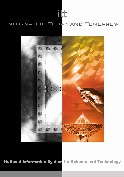
Vol 21 No 2 June 2002
We are in the throes of another revolution in knowledge communication. The complacent publishing industry that has been in deep slumber for 550 years since Gutenberg invented the printing press in 1452 AD is now being shaken up with the advent of e-media. Authoritarian ways of the traditional publishers have also come under threat (Authors never had it so sweet!). But how real is the threat?
An assessment or forecasting is easier if the change is continuous, and the past is the guide to the future. In this case, the change is discontinuous as a new technology is involved, and the technology is yet growing at a fast pace without a state of maturity in sight. Only plausible conjectures can be made.
The new avatar e-book has many advantages over its ancient relative the print-on-paper books or p-book in short. Authors can avoid the hassles of a middleman, secure more returns and they can easily update the materials. It is also not a loosing proposition for publishers. They can produce and distribute a product quickly. Neither they need to bother about the print runs and the size of the book, as these parameters no more influence investment demands. The distributors or retailers also stand to gain, as they can avoid investments in transportation and storage. Upfront investment requirements being minimal, the uncertainties about the off take of the product do not count much. Therefore, the decision to accept a manuscript for publication becomes easy to take.
From the users' (readers') point of view however, the scenario is not all that rosy. They could eventually access the world of knowledge at a fraction of the present costs. However, only a limited few have the required access. Those who do not use computers in their daily routine are also not expected to click to read from a screen. For the reader- hardware is still expensive (and would remain so unless the features of desktops, e-book readers, PDAs and palmtops are bundled into one device). Their friendliness and portability suiting to all kinds of environment are questionable.
It is, therefore, not possible to infer either way whether the threat is real.
In the present scenario, e-journals have already made a mark but more often than not these have p-versions also (and publishers have invented all kinds of tricks to lure the librarians in procuring both the e-copy and the p-copy). After the much hyped CD-ROM variants of encyclopedia have ended up in a whimper, the Encyclopedia Britannica has resorted to web publishing _ the fortunes are not known. Indexing & abstracting databases are now firmly entrenched in the net. What about entertainment and leisure materials _ the storybooks?
The solitary case often cited is the book Riding the Bullet by Stephen King, which is available only in e-format and cannot be printed out. First of all, it is the brand equity of "Stephen King". Secondly, it is only 66 pages long _short enough for people to read on the screen (imagine reading 1153 pages of The Stand on screen). Besides, it had the back up of the giant publisher Simon & Schuster and booksellers like amazon.com and barnesandnoble.com. No wonder that the 500,000 copies of the book were sold. But the success of "Riding the Bullet" owes more to the back up promotion than to the quality of the product or the greatness of the medium used. Therefore, this cannot be taken as a guide to the future.
There is another model though not exactly of e-publishing. The print-on-demand services of iUniverse.com can be availed of at as low as $99 ($299 with full editorial review). The royalty rate is also high: 20%. Even though there are as many as 7200 titles (very few offers get rejected anyway), it has failed to attract public attention.
Similarly, a phenomenally high 50% royalty offer (while traditional publishers pay only 5-15%) of Fatbrains.com and its subsidiary MightyWords.com have not tempted any big author to break away from the clutches of their publishers. So what is finally the conclusion?
The advent of e-publishing would make a strong impact on the royalty structure offered by the traditional publishers. The e-publishing route would definitely have a niche in vanity publishing. More and more textbooks will be e-published, if interactivity with authors is provided, downloading is allowed and the students are charged less and on " as use" basis. Reference text and e-journals would constitute the greatest niche market _ so is for informational materials like directories.
For entertainment and leisure use, e-publishing does not appear to have a future in the immediate range. This is especially true for the generation who has seen a computer only at the fag end of their life. When computers get internalized to the daily life, the future may show up.
The e-book publishers will not be able to sustain unless they are able to net renowned contemporary authors because publication of classics and of materials out of copyright cannot generate adequate revenue. On the other hand it is also true that if the traditional publishers fail to perceive the potential of the new technology and familiarize themselves, their business might dwindle in the medium range future.
Would the revolution touch India? True that Indians are tired of all kinds of divides. Now they have to grapple with another _ the Digital Divide due to disparities in literacy, income, geographic location, access facilities and so on. Not all, but definitely a small section of the population, would directly derive the benefits. However, Indians have always been innovative and accustomed to fighting against odds and we shall find our way.
Not to worry! A revolution always begins with a trickle but ends in a flood.
— A. Lahiri
Information Today & Tomorrow, Vol. 21, No. 2, June 2002, p.1-p.2
http://itt.nissat.tripod.com/itt0202/edtl0202.htm





















